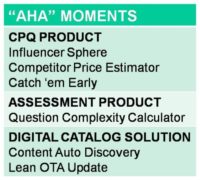We come across the “Go Wide or Go Deep?” question regularly in our outsourced product management engagements. (Should the term “outsourced product management” intrigue you, see Who The Heck Outsources Product Management?).
Let’s take a typical scenario:
An IT company has developed a technology platform without reference to any specific segment. The going in position of the company is to target the platform at all segments (“Go Wide”) rather than focus only on one segment (“Go Deep”). To quote the founder of one such company, “Our platform is suitable for everyone, why should we artificially restrict it to any one segment?”
Fair question, the answer to which will become evident once we take a look at the go to market big picture.
In this post, we’ll look at the pros and cons of the Go Wide and Go Deep approaches and share actionable insight on which approach would work for what kind of platform.
To begin with, here’s a working definition of the term “segment”: It refers to Industry Vertical (e.g. Financial Services, Life Sciences), Geography (North America, Asia Pacific) or Domain (e.g. Payment Fraud, Clinical Research).
Each segment has its own attributes in terms of size, hype, growth, profitability, appetite for technology, future outlook, and so on. The uniqueness of each segment creates the following challenges for the platform’s GTM strategy:
- Product Challenge: Each segment requires the functionality unique to it. Such functionality must be built into the core platform, otherwise the platform will have no value
- Marketing Challenge: Each segment has its own unique pain areas and hot topics. Therefore, a single positioning strategy will not work across all segments
- Sales Challenge: Each segment has its own affordability and organization structure. Therefore, a single pricing and distribution strategy will not work across all segments.
In theory, it’s possible for a product vendor to overcome these challenges by developing multiple versions of functionality, messaging and pricing so as to address the unique needs of each segment. But in practice, it requires very deep pockets to execute this approach.
I’ve worked with some great board members and some horrible ones for startups. Bad Board Member (BBM) v. Good Board Member (GBM). Stealing format from @bhorowitz.
1/ BBM will always say “let’s do that too.” GBM recognizes resources are finite and encourages focus.
— Ryan Caldbeck (@ryan_caldbeck) March 8, 2018
Ergo, while Go Wide has the obvious advantage of offering a larger addressable market, Go Deep might be the right approach in many situations.
As a rule of thumb, follow the Go Deep approach if your platform faces the Product Challenge and the Go Wide approach if it does not.
Go Deep
 Go Deep if your platform faces the Product Challenge.
Go Deep if your platform faces the Product Challenge.
Choose only one segment. Build all the core functionality, best practices and KPIs required by that segment into your core platform. Ignore other segments. No doubt, your platform can be used only by companies in the segment chosen by you. While your target addressable market would come down as a result, you’d have a much better shot at dominating the segment you’ve chosen.
Qwikcilver is a good example of a company that followed the Go Deep approach and reaped a rich harvest. Speaking to Economic Times, its Cofounder Kumar Sudarshan explained his approach in the context of his company’s Stored Value platform as follows:
As a technology, we created what we called a store value platform. This allowed us to undertake technology for a loyalty and gift card programme, discount and meal cards, etc. It was a generic platform which could power several different types of card-based applications. In the early days, there was a lot of clamour to position ourselves as a platform offering multiple programmes and that is how we pitched ourselves to our customers. While this worked to an extent, we realised each of these ecosystems were different by themselves. This particular platform that we had, would not be complete unless we built the entire aspects of the ecosystem in our product. We realised early on, that our efforts and energies were getting dissipated across various solution spaces. That’s when we took an important call to establish ourselves uniquely in the giftcard segment alone, which was nascent and build it out.
As you can see, the company learned that
- the different segments to which the platform appealed – gift card, discount and meal card – were different in themselves
- each segment had its own needs
- unless the platform supported the needs of each segment, it would be incomplete and unsaleable.
Coupled with finiteness of resources, this realization was the tipping point in the company’s decision to focus solely on gift cards.
By going deep, the company has been able to command a dominant – reportedly 90% – market share in the gift cards segment.
Go Wide
 Go Wide if your platform does not face the Product Challenge.
Go Wide if your platform does not face the Product Challenge.
Build out your base platform with segment-agnostic functionality. Ignore segment-specific functionality in your platform. As and when customers demand deep, segment-specific functionality, develop them as paid enhancements or fulfill them by partnering with with third-party addon solutions specializing in that segment. In the present era of APIs and microservices, partnerships are becoming increasingly seamless.
ERP is one product where many vendors have followed this approach successfully. The basic platform has the functionality required to digitize a broad array of industries across many geographies (i.e. segments). While many customers do require segment-specific functionality, that need is often felt only in the proverbial “Phase 2”, which comes after the basic business processes have been digitized by the broadbased platform. So, until then, the “go wide” strategy works.
We must hasten to add that, even when the product follows “go wide” approach, the GTM strategy must always go deep. That’s because the going-in position of most enterprise software buyers is that their segment is unique, so they tend to reject a “horizontal” platform as a solution for their “vertical” needs. Like the bespectacled gentleman in an old SAP ad says, “I know SAP has 23 industry solutions. I don’t care about 22 of them”.
Therefore, it’s necessary to create segment-specific messaging to resonate with buyers at the top of the funnel even when the product goes wide.
While building a business case for ERP, "go deep, not wide". Just by solving 2-3 problems, ERP can deliver high ROI. http://t.co/HTKFR4VXQL
— GTM360 (@GTM360) August 28, 2013
 Using the guidelines given in this post, it should be possible for product vendors to decide whether to Go Deep or Go Wide.
Using the guidelines given in this post, it should be possible for product vendors to decide whether to Go Deep or Go Wide.
Once you’ve taken that decision, you’ll then need to select your segment or segments, scope their functionality, and devise “aha” moments in your platform. Then comes the stage of developing segment-specific GTM strategy comprising Marketable Items, Marketing Collateral and Pricing Plans for each segment.
If you need help with any of these steps, feel free to contact us.
UPDATE DATED 13 JULY 2018:
Justin.tv is a great example of a company that started with the “go wide” approach, nearly went bankrupt, then pivoted to adopt the “go deep” strategy and became a blockbuster success.
While you can find the complete details here and here, given below is the tl;dr version:
Justin.tv started off as a general-purpose streaming TV platform. That is, it took the “go wide” approach. In early 2010 it had 50 employees and 8 months of runway. It had users (30M monthly actives) and revenue ($4-6M revenue run rate) but wasn’t growing so its founders tried to fundraise and buy themselves more time. They failed.The company cut expenses and took stock of what it had built. After a lot of brainstorming, it decided to “go deep” and carved out the following offshoots from the original general-interest platform:
- “Instagram for video”
- Streaming platform for gamers. The company made a few enhancements that made the platform truly awesome for this target audience.
The first sub-platform became Socialcam and exited for $60M.
The second sub-platform became Twitch.tv, which became way more popular than its general-interest parent Justin.tv and achieved an exit of $1B to Amazon.
